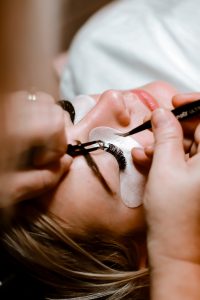 Grab your lab coat because it’s time to delve into the surprising science behind eyelash glue and adhesive. When people think of eyelash extensions, they think of gorgeous, fluttering eyelashes that turn heads everywhere they go. But the unsung heroes of these luscious lashes that you see are the adhesives used to keep them in place.
Grab your lab coat because it’s time to delve into the surprising science behind eyelash glue and adhesive. When people think of eyelash extensions, they think of gorgeous, fluttering eyelashes that turn heads everywhere they go. But the unsung heroes of these luscious lashes that you see are the adhesives used to keep them in place.
More goes into the makeup of eyelash adhesive than many may first realise, though, as it requires a fairly complex combination of chemicals to achieve the results both lash techs and clients want. This article is going to take lash glue through a microscope and break down all the different chemicals that go into making up lash adhesives.
The ingredients in lash adhesives
Cyanoacrylate
Cyanoacrylate is an ingredient that is found in all lash adhesives and is responsible for fast bonding. There are actually many different types of cyanoacrylate, but the most common type that is used in the lash adhesive is ethyl-cyanoacrylate due to its fast-drying, resin-like properties. This ingredient is what is referred to as an acrylic monomer which turns to plastic when it cures.
Polymethyl methacrylate (PMMA)
Polymethyl methacrylate, commonly known as PMMA, is another essential ingredient found in lash adhesives. The ‘poly’ refers to the fact that this ingredient polymerizes, the ‘methyl’ means that there is one carbon atom present and the ‘acrylate’ means that there is also the self-hardening acrylic acid. Whilst cyanoacrylate is the ingredient responsible for the fast-dying properties, PMMA is the ingredient that’s responsible for the strong, long-lasting bond. It essentially comes in and reinforces the cyanoacrylate to help keep lash extensions stay put for longer. PMMA enhances the overall strength of the adhesive bond, allowing the extensions to withstand everyday activities without easily detaching.
Carbon black
Carbon black is a pigment commonly added to lash adhesives to give them a dark, black colour. Carbon black is not found in all lash adhesives, however, as some adhesives you’ll find will be clear. However, when used, this pigment helps the adhesive blend seamlessly with the natural lashes, creating a more natural and sleek look.
How does lash adhesive work anyway?
The lash adhesive works through a combination of chemical processes and physical properties. When the lash adhesive comes into contact with moisture in the air or on the natural lashes, it begins to polymerize and form a strong bond. The adhesive’s molecular structure allows it to adhere to both the synthetic lash extensions and the natural lashes, creating a secure attachment.
The surface tension of the adhesive ensures that it spreads evenly and adheres to the lashes without clumping or causing discomfort. This property also helps prevent the adhesive from seeping into the eyes or causing irritation.
The adhesive’s drying time may vary depending on the formulation and brand. It is essential to follow the instructions provided by the manufacturer to allow the adhesive to dry fully and achieve optimal bond strength.
Drying vs curing: Is there a difference?
Drying refers to the evaporation of the adhesive’s solvents, which allows it to solidify and form a bond. During the drying process, the adhesive transitions from a liquid to a solid state, providing initial adhesion between the lash extensions and natural lashes. It is important to note that even though the adhesive may appear dry on the surface, it may still continue to strengthen over time as the curing process takes place.
Curing, on the other hand, involves the complete polymerization of the adhesive. The curing process continues after the initial drying phase and can take up to 24-48 hours, depending on the adhesive formulation. During this time, the adhesive reaches its maximum strength and durability, ensuring that the lash extensions stay securely attached.
Innovations in eyelash adhesive
The beauty industry is continuously evolving, and eyelash adhesive is no exception. Recent innovations have led to the development of latex-free formulations, addressing concerns for those with latex allergies. Furthermore, advancements in adhesive technology have improved durability, ensuring that lash extensions stay in place for longer periods. Online stores such as BELO Lash have a clear focus on creating quality products for lash techs and are always innovating, using science to create better adhesives and lash extensions.
Conclusion
Whilst lash adhesives are something that is used every single day when applying eyelash extensions, there often isn’t too much attention given to the science behind them. A lot of the spotlight is often on the extensions themselves and how the many different styles are made, but without the lash adhesive none of this would be possible.



